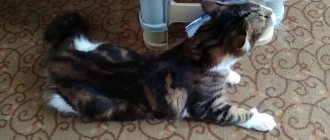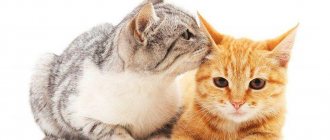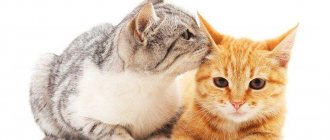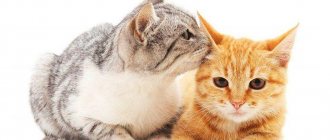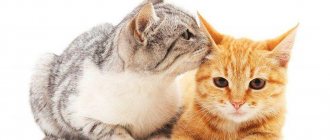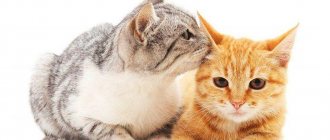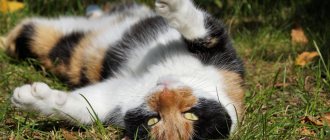When a cat begins to ask for a cat, the owner who has encountered this for the first time is very worried. After all, during sexual heat, the pet screams wildly and behaves inappropriately. Not every person is able to remain calm; many are looking for any ways to calm it down. Folk remedies, sedative pills and even hormonal drugs are used.
Let's find out which methods of suppressing the symptoms of estrus are safe for cats and why you should decide to sterilize.
At what age does a cat start walking?
Cats start yelling at different ages. In some animals, puberty occurs earlier, in others - later. This depends on many factors:
- breed affiliation;
- fatness;
- conditions of detention;
- pet's temperament;
- heredity.
The first time a cat begins to ask for a cat is when mature eggs are already being produced in her ovaries. In most cases, sexual heat begins between 6 and 10 months, but there are exceptions.
In any case, mating during the first few heats is not advisable. After all, for the body to fully form and strengthen, it needs more time.
It is extremely rare for cats to start asking for a cat at the age of 5 months. Such early maturation indicates the presence of health problems. In this case, it is advisable to show the animal to a veterinarian. You will also need to consult a specialist if your first heat starts after a year.
First heat
Typically, a cat's first heat begins between 6 and 10 months of age. Sometimes a four-month-old kitten may go into heat, which is considered a deviation from the norm. In this case, the animal should be shown to a doctor. In some cases, estrus does not begin even after one and a half years of age. This is a signal that something is wrong with the cat's health.
Factors that influence when a cat goes into her first heat:
- Heredity.
- Animal size.
- The presence of a mature cat in the house.
- Health status.
- Does the cat have access to the outside? Outdoor cats often mature earlier. Since the average lifespan of street cats is shorter than that of domestic cats, they try to leave offspring as early as possible.
- Breed.
It is worth noting that a cat’s first estrus may be blurred, without obvious symptoms. The owner may not even know that his pet has already formed and is quite ready for mating. However, even during an asymptomatic period, a cat can become pregnant. This is why keeping kittens of different sexes older than six months together is somewhat risky.
Cat puberty occurs earlier than physical maturation. This is why you should not mate a female during her first heat: this can lead to a difficult pregnancy, problems during childbirth, and behavioral disorders (it happens that mothers who are too young do not want to take care of their kittens).
Often, breeders mate cats for the first time at the age of one and a half years, when the female has already gone through 2-3 heats. At this age, the cat is already old enough, and the risks of pregnancy are minimized.
Symptoms of estrus
It's impossible not to notice when a cat asks for a date with a cat. Signs by which you can determine that your pet has gone on a spree:
- The cat screams and meows protractedly at the top of her voice. Some owners get scared - they think she is sick. In fact, this is a natural process. The female attracts potential suitors with a loud cry.
- When a cat asks for a cat, she leaves marks in the house. It is unknown whether she does this on purpose or not. The fact is that during the hunting period a special mucous secretion is released from the vulva. In nature, its smell attracts cats.
- The cat becomes very affectionate, gentle, constantly rubs against the owner’s legs and purrs. In rare cases, the pet behaves in the opposite way - it becomes irritable and aggressive.
- The urge to urinate becomes more frequent.
- When a cat asks for a cat, she takes a characteristic pose - arching her back and raising her butt. The tail is moved to the side. In this way, the female shows the male that she is ready for mating.
- It is easy to understand that a cat wants a cat by its loss of appetite. The pet rarely approaches the food bowl and eats little. Some individuals generally lose interest in food, they even refuse their favorite treat.
You should not worry about the cat’s well-being during this period - when the heat ends, everything will return to normal. The behavior will become habitual, an appetite will appear, and the pet will stop behaving inappropriately.
What is estrus
Estrus is a period during which a cat experiences hormonal, physiological and behavioral changes. They are associated with the female’s readiness to mate and bear offspring.
The period of estrus is accompanied by severe stress for the animal. The cat becomes restless, loses its appetite, constantly screams and looks for a male. It is during this period that cats are most prone to escape. Due to the effects of hormones, they are not able to adequately assess the danger, and therefore can even jump out of an open window from a high floor.
The period of estrus often becomes a real test for both the cat and its owner. It is worth noting that empty heats (if the cat has not mated and become pregnant) are very dangerous for the health of the animal. They often lead to inflammation of the ovaries, pyometra (a deadly disease), mammary gland cancer, and other disorders in the animal’s body.
That is why veterinarians often advise sterilizing all cats that do not have breeding value and do not participate in breeding. This will protect both the owner’s nerves and the health of his pet, and no more stray kittens will appear on the street.
Duration and frequency of sexual heat
The length of the period during which cats ask for a cat differs from individual to individual. On average, estrus lasts 7-10 days.
The period of sexual hunting can be divided into several stages. Each of them has certain characteristics:
- Proestrus. The cat begins to ask for a cat, but at the same time she is not yet ready for effective mating. Her estrogen levels increase. Sexual heat begins - the external genitalia increase slightly in size, and transparent discharge appears from the vulva. Behavior changes - the cat rubs against objects for a long time, requires more attention and affection. Appetite decreases. The duration of proestrus is 2-3 days.
- Estrus. The cat is already ready for mating. If she has a date with a cat during this period, she is more likely to get pregnant. The pet feels increasing excitement, this is eloquently evidenced by her behavior - loud inviting cries, adoption of a characteristic pose for mating. The duration of estrus is 3-4 days, in some individuals it lasts longer.
- Metestrus. The level of estrogen in the cat’s body decreases, and along with it, interest in representatives of the opposite sex disappears. Some females even feel irritated at the sight of a male. The cat no longer asks the cat, does not allow him to approach, drives him away with hiss.
- Anestrus. At this stage, the hormonal levels stabilize and the cat calms down.
The frequency of the onset of estrus differs between domestic and wild animals. This process is influenced by the length of daylight hours, quality of nutrition, breed and other factors.
On average, cats ask for a male cat every 3-4 weeks, provided that mating has not occurred.
How to calm a cat during heat
First of all, the owner should immediately decide whether his pet will participate in breeding. It should be noted that childbirth is a rather complex process. Some owners believe that childbirth will only benefit their pet. But this is far from true. Pregnancy consumes a lot of resources, it wears out the body. In addition, pregnancy is accompanied by various risks, which may well lead to the death of the mother and cubs. This is why you should not breed animals that have no breeding value. Pregnancy will not bring any benefit to the cat itself, and outbred kittens often end up on the street.
If the cat will not participate in breeding, it should be sterilized. Moreover, it is advisable to do this before the age of one. At this age, the animal’s body has not yet encountered hormonal storms. The uterus is small in size, it can be easily removed, and the animal will quickly recover after the operation. But it is worth noting that surgery done too early can lead to problems with urination in the animal. Therefore, it is advisable to sterilize a cat at the age of 6-7 months.
If the cat does not participate in breeding, or it cannot be sterilized for some reason, then there are other ways to help the pet. During this period, the cat really needs affection and attention. The pet should be petted more often and treated affectionately.
Even if the cat does not behave quite adequately, you should be patient. You shouldn't scold her. The cat cannot control some of its impulses, and it is not her fault. Taking your anger out on an animal, beating it, scolding it is not worth it. This can lead to mental disorders, due to which the cat may begin to behave inappropriately not only during periods of heat.
There are medications that can calm the animal. They are often made from various plant components. Such medications act as a sedative, but they do not stop the estrus itself. You should consult your doctor before giving your cat any medications. Some of them are not at all harmless - they can cause drowsiness and seriously affect the behavior and health of the animal.
There are also hormonal drugs. They are just capable of completely stopping estrus. But using them is strictly not recommended. Such medications lead to various diseases of the cat’s reproductive system. Hormonal drugs are good for the owner, since due to their effect the animal does not go into sexual heat. But these medications have a negative effect on the health of the animal, and therefore they should be purchased only as prescribed by a doctor.
How long after giving birth does estrus occur?
The frequency of sexual estrus depends on whether pregnancy has occurred. If a cat has a date with a cat, then she bears the offspring for about 2 months, and then feeds them. Then the next estrus begins 30-50 days after lambing or 10-14 days after the end of lactation. In the wild, cats go into heat on average 2-3 times a year. If there was no mating, then the next time the estrus will begin in 3-4 weeks.
In rare cases, nursing cats ask for a male cat as early as 2 weeks after lambing. If mating does not occur during this period, the next estrus will begin again after 14-21 days.
If the date with the male takes place, then a new pregnancy will not occur, since the uterus has not yet had time to recover and the process of feeding the kittens is underway. But mating during the next heat is more likely to be effective.
Frequency and duration of estrus
The body of each animal is individual, therefore it is impossible to determine the exact timing and frequency of estrus in an individual cat. However, there are approximate dates that the sexual cycle of an animal should normally correspond to. A cat's heat can last from 6 to 10 days. Some cats can be in the period of active sexual hunting for up to 20 days. The duration of estrus is influenced by many factors. In young animals, heat can last only a couple of days. With age, the cycle will return to normal. Also, the duration of estrus depends on the weight of the animal, breed, living conditions, and state of health.
The frequency of estrus depends on the following factors:
- Health status.
- Breed. In Siamese and Persian breeds, estrus occurs every three weeks, but in British and Scottish breeds, the resting period can be up to 3 months.
- Conditions of detention.
- How quality is the food?
- Season. In winter, cats begin a long period of rest, but in the spring the frequency of estrus resumes. However, in animals that live in warm rooms around the clock, the frequency of estrus does not depend on the time of year. They are often ready to mate all year round.
- Heredity.
- Excess weight or excessive thinness.
- Stress. If the cat is in a stressful environment, estrus may stop altogether.
- Age of the cat. The older she is, the less often estrus occurs.
We recommend the article: Ringworm in cats: types and main signs, treatment and prevention
If a cat becomes pregnant during estrus, the next heat will begin only three months after the kittens are born. Although there are cases when a cat becomes ready to reproduce immediately after giving birth. It also happens that a false pregnancy may occur as a result of estrus. All symptoms indicate that the cat is expecting kittens, and the cat herself is sure of this, and therefore she begins to actively prepare for future motherhood. In this case, the cycle may also be slightly disrupted.
Behavior problems
When cats ask for a date with a cat, household members have a hard time. The constant screaming makes it impossible to sleep at night. Some people can’t stand it and lock their pets in one of the rooms. Others wet the animal’s fur with water in the evenings. This allows you to gain an hour of silence while the cat licks its fur coat. But as soon as she dries up, she starts asking for the cat again. This behavior is exhausting and forces you to try different ways.
Is it possible to calm a cat at home?
Simply petting and calming a cat that asks for a cat is unlikely to work. You will have to be patient and wait until the heat ends.
Numerous “folk” tips on how to calm a pet usually turn out to be ineffective:
- Pet your pet more often. Showing attention will only increase arousal.
- Give sedatives. They will not help because the animal is not stressed. They are driven by the instinct of reproduction. Such medications only slightly dull the desire to mate.
- Feed the cat with products containing pheromones like Feliway. During sexual hunting they are completely useless. Such drugs help to quickly adapt to a new place and to endure the trip more calmly, but they do not pacify natural instincts.
Calming medications for cats
Sometimes veterinarians recommend taking sedatives. Such medications help to dull arousal a little, but their main purpose is to achieve mental lability, eliminate aggression and anxiety.
List of drugs and method of use:
- Cat Baiyun. A medicine based on herbs with a sedative effect - valerian roots, oregano, sweet clover, mint, motherwort, hop cones and others. As soon as the cat begins to ask for a cat, she is given 2 ml of medicine three times a day for 5-7 days.
- Fitex drops. A sedative with herbal components – valerian, motherwort, hop extract. The medicine normalizes the functioning of the central nervous system, muffles the feeling of fear and aggression. If a cat wants a cat, or vice versa, then the pet is given 3-5 drops of the product in the morning, lunch and evening for several days.
- Drops for cats Stop stress. The drug is available in the form of drops and tablets. The medicine contains aminophenylbutyric acid and extracts of valerian, catnip, hops and motherwort. This remedy helps reduce agitation and correct the animal's behavior in stressful situations. Directions for use: 1 drop per 1 kg of weight twice a day.
Sedatives should not be given to a cat for a long time. They are allowed to be used for no more than 10 days. And you should not expect that these medications will completely eliminate sexual arousal. They can only slightly smooth out the symptoms of estrus.
Artificial ovulation
Sometimes the safest and most effective way to calm a cat so that she does not ask for a cat is to artificially induce ovulation. This method is suitable if the pet cannot be given for mating right now for some reason. For example, if she is in her first heat or a worthy candidate for mating has not yet been found.
In some cases, veterinarians show owners how to simulate sexual intercourse at home, which will cause ovulation. To do this, you will need a small phallic-shaped object about 4-5 mm thick and 1.5-2 cm long. A cotton swab wrapped in a fingertip or something similar will do. The cat is held by the withers. When she is in the mating position, the object is gently inserted into her vagina.
It is recommended to repeat this procedure 3-4 times within 12 hours. After this, the pet should ovulate, which will provoke a false pregnancy.
The heat will stop, the cat will calm down, stop asking for the cat and will prepare for the appearance of kittens. Some females begin to arrange a place for birth. During a false pregnancy, hormonal changes occur, so milk may be released from the mammary glands.
Attention! The artificial ovulation technique cannot be used every time the cat asks for a cat. This can cause inflammation in the uterus.
What not to do
Some actions of owners can harm the cat. For example, you cannot lock an animal in a cellar or bathroom. Being alone will have a negative impact on your mental health.
It is also undesirable to let your cat outside unattended, because it could get hit by a car, contract a virus, or become a victim of aggressive dogs. In addition, uncontrolled walking during estrus can lead to mating with an outdoor cat.
You should not punish her, yell at her, or hit her. This will not help solve the problem, because the animal is at the mercy of instincts. The pet will still continue to scream and roll on the floor.
What is estrus?
The word "estrus" is the scientific name for estrus. During estrus, psychophysiological changes occur in the body. Follicles mature in the animal’s ovaries, ovulation occurs, and conception becomes possible. During estrus, your pet's behavior changes noticeably.
The following signs indicate that a cat is walking:
- The pet becomes overly affectionate, or, conversely, shows inexplicable aggression.
- Meows loudly and invitingly. During estrus, a cat can call for a male for days. Read the article “Why does a cat constantly meow and yell throughout the day?”
- Frequent urination due to physiological changes in the body.
- The presence of clear discharge on the genitals. Therefore, your pet will lick itself more often.
- There is also a decrease in appetite. For some, interest in food may disappear altogether. This condition can occur in the first few days of estrus. Although some people may experience worsening appetite throughout the entire estrus phase.
- The genitals may be slightly swollen. But often only an experienced veterinarian can recognize this.
- Changes in gait. The cat bends its front legs halfway, raises the back of its body, lifts its tail or moves it to the side.
- The cat may begin to mark its territory.
These signs can be observed alternately or in combination.
Interrupting estrus with hormonal drugs
Estrus can be prevented or interrupted with the help of hormonal medications. However, they should not be used often, as this will lead to health problems.
List of drugs to suppress sexual arousal in cats:
- Sex Barrier;
- EX-5;
- EX-5T;
- Four with a tail.
Hormonal drugs are designed to reduce the level of estrogen, which will reduce the manifestations of sexual desire. Essentially, taking such medications moves the animal from proestrus to anestrus.
Pros of taking hormonal drugs:
- the cat does not ask the cat, its behavior does not cause inconvenience to the owner;
- it is possible to skip 1-2 matings if the animal is used for breeding, but mating is not possible at the moment.
There are just as many disadvantages to taking hormonal medications. This needs to be understood when deciding whether to give them to your pet:
- such medications cannot be used frequently and for a long time;
- taking them disrupts hormonal levels, and this can lead to serious illnesses - the development of pathologies in the uterus and oncology.
Problems do not appear immediately after taking hormonal drugs. Most often they occur at the age of 3-4 years. If a cat develops endometritis or other diseases of the reproductive system, it will have to resort to castration.
A sterilized cat is in heat
It happens that even sterilized cats continue their estrus cycle. There may be several reasons for this:
- The operation was performed incorrectly.
- The ovaries were not removed, or ovarian tissue remained in the abdominal cavity.
- Sex hormones are secreted by a tumor, which can be located in the uterus, mammary glands, adrenal gland, or pituitary gland.
- The adrenal glands and pituitary gland continue to produce sex hormones even after the ovaries are removed.
We recommend the article: Rectal prolapse in cats: treatment, prevention measures
Often, the attenuation of sexual behavior does not occur immediately after sterilization. Sex hormones still circulate in the cat’s body, which lead to behavioral abnormalities. Sexual behavior subsides approximately 2-8 weeks after surgery. But in some animals it can last much longer. This is especially true for cats that have been spayed during estrus.
The age of the cat also affects how quickly the animal's behavior is corrected. The more heats a cat has experienced, the older she is, the greater the chance that sex hormones will begin to be actively secreted not only by the ovaries, but also by other glands. This means that late sterilization of a cat may not be effective in correcting the animal’s behavior. The cat will not be able to become pregnant after the operation, but signs of sexual heat will continue to be observed in the future.
Sterilization
To get rid of your pet’s meticulous screams forever, it is recommended to carry out a sterilization procedure. This method is suitable only for those who do not want to breed cats.
Veterinarians now recommend neutering rather than a simple tubal ligation. This is an abdominal operation to remove the uterus and ovaries. It is done under general anesthesia.
The appropriate age for surgery is when cats start begging for the first time. That is, approximately 6-7 months. It is advisable to have the operation done before the first heat.
Pros and cons of castration:
| pros | Minuses |
| The lifespan of a cat increases by 1.5-2 years | Since the operation is performed under general anesthesia, there is a possibility of complications. |
| The cat does not yell, behaves calmly, does not cause inconvenience to the owner | |
| There is no need to look for partners for mating and think about where to put the kittens | |
| The pet's risk of developing mammary gland cancer, ovarian and uterine pathologies is reduced |
The case for castration also holds true for males. In addition to the fact that cats start screaming when they ask for a cat, they leave marks in the apartment with a pungent musky odor. Rather than endure this, it is better to have surgery and forget about sleepless nights. Today this is the most effective way to solve the problem.
How long and often do cats walk?
Many owners are concerned about how much the cat walks and how often. It is difficult to give specific answers to these questions. Each representative of the cat family will have its own indicators. In addition, several factors influence the duration and frequency of estrus.
How many days a cat's heat lasts depends on:
- environmental conditions, season;
- conditions of detention;
- feeding characteristics;
- animal breeds;
- age of the cat;
- presence of contacts with cats;
- physiological characteristics of the pet’s body;
- health status.
True, there are averages. From 5 to 10 days - this is how long the estrus lasts for a cat living at home. But everything is individual. In rare cases, estrus can last up to 20 days. The first heat is most often short-lived and becomes longer over time. So, the number of days a cat walks for the first time does not mean that her estrus will continue to be of the same duration. The hormonal background has not yet fully formed.
It is recommended to observe how many days the cat is in heat, because sometimes it can be too long. And prolonged estrus is a pathology. Similar situations can occur with an ovarian tumor or cystic process. It is highly undesirable to start such diseases. Therefore, it is important to know how long a cat’s heat is normally. And in case of deviations, contact a veterinary clinic in a timely manner. The doctor will perform an ultrasound, take blood samples and, if necessary, prescribe a treatment regimen.
Sometimes it happens that the cat does not leak at all. This may be the cause of the development of some disease. Therefore, a visit to the veterinarian cannot be avoided. If the cat does not start walking, experienced breeders advise taking the following measures:
- If there is another cat who is currently in heat, she should be placed with a pet who is not starting to walk. Often cats leak at the same time. And the second one may also leak.
- If you have a cat, it is advisable to place it with a cat. The smell of a cat can cause hormonal changes in the pet's body, and the pet will begin to walk.
- You can give your pet vitamins and homeopathic remedies. Naturally, on the recommendation of a veterinarian. This method is only suitable for healthy cats.
The question of how long a cat’s first heat lasts is clear. But how often does the animal walk? As for frequency, if the cat has already given birth, then, as a rule, estrus occurs once every few months. Sometimes the interval can reach a year. But if your pet has not given birth before, estrus may bother you more often. For example, monthly or even every 2 weeks. As for stray animals, as well as older individuals, their estrus usually occurs in the fall or spring.
The question of why a cat often walks is understandable. But what to do in this situation? The best option is to give the animal the opportunity to reproduce regularly. Thus, it is possible to achieve that the heat will occur once every six months. But it is worth noting that a cat’s first heat after giving birth may appear after just 1-1.5 months. If the owner does not plan to breed cats at all, it is worth contacting a veterinarian. The animal can be sterilized. Or the doctor can choose hormonal drugs.
